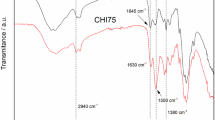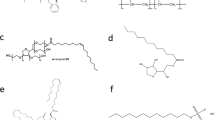Abstract
Purpose
To investigate the phase behavior of resveratrol amorphous solid dispersions upon addition to aqueous media.
Methods
Polymers with different crystallization inhibitor properties were used to form amorphous solid dispersions of resveratrol. Resveratrol crystallization in aqueous environments was monitored over time using Raman spectroscopy, and solution concentrations were determined by ultraviolet (UV) spectroscopy.
Results
The crystallization behavior varied depending on the type and amount of polymer present in the dispersion. Polyvinylpyrrolidone (PVP) and Eudragit E100 (E100) dispersions did not crystallize for 24 h when slurried in pH 6.8 buffer at 37°C. Even though no crystallization occurred, a supersaturated solution was not achieved, most likely because of resveratrol-polymer complexation. Dispersions formed with cellulose derivatives crystallized rapidly, and the extent of crystallization varied depending on the amount of polymer in the dispersion. The solution concentration achieved in the slurries varied considerably between the various solid dispersions and depended on several factors including the extent of resveratrol crystallization, the nature of the resveratrol-polymer interactions, and the concentration of solid dispersion added to the slurry.
Conclusions
It was found that the extent of supersaturation was limited not only by crystallization, but also by soluble and insoluble complex formation between resveratrol and the polymer.











Similar content being viewed by others
Abbreviations
- CMCAB:
-
Carboxymethyl cellulose acetate butyrate
- E100:
-
Eudragit® E100
- HAS:
-
Hydrochloric acid solution
- HPLC:
-
High performance liquid chromatography
- HPMC:
-
Hydroxypropyl methyl cellulose
- HPMCAS:
-
Hydroxypropyl methyl cellulose acetate succinate
- PB:
-
Phosphate buffer
- PVP:
-
Poly(vinylpyrrolidone)
- RH:
-
Relative humidity
- UV:
-
Ultraviolet spectroscopy
References
Leuner C, Dressman J. Improving drug solubility for oral delivery using solid dispersions. Eur J Pharm Biopharm. 2000;50:47–60.
Serajuddin ATM. Solid dispersion of poorly water-soluble drugs: early promises, subsequent problems, and recent breakthroughs. J Pharm Sci. 1999;88:1058–66.
Hancock BC, Zografi G. Characteristics and significance of the amorphous state in pharmaceutical systems. J Pharm Sci. 1997;86:1–12.
Alonzo DE, Raina S, Zhou D, Gao Y, Zhang GGZ, Taylor LS. Characterizing the impact of hydroxypropylmethyl cellulose on the growth and nucleation kinetics of felodipine from supersaturated solutions. Cryst Growth Des. 2012;12:1538–47.
Lechuga Ballesteros D, Rodriguez Hornedo N. Effects of molecular-structure and growth-kinetics on the morphology of L-alanine crystals. Int J Pharm. 1995;115:151–60.
Vandecruys R, Peeters J, Verreck G, Brewster ME. Use of a screening method to determine excipients which optimize the extent and stability of supersaturated drug solutions and application of this system to solid formulation design. Int J Pharm. 2007;342:168–75.
Wegiel LA, Mauer LJ, Edgar KJ, Taylor LS. Crystallization of amorphous solid dispersions of resveratrol during preparation and storage—impact of different polymers. J Pharm Sci. 2013;102:171–84.
Kestura US, Taylor LS. Role of polymer chemistry in influencing crystal growth rates from amorphous felodipine. Cryst Eng Comm. 2010;12:2390–7.
Kestur US, Van Eerdenbrugh B, Taylor LS. Influence of polymer chemistry on crystal growth inhibition of two chemically diverse organic molecules. Cryst Eng Comm. 2011;13:6712–8.
Konno H, Taylor LS. Influence of different polymers on the crystallization tendency of molecularly dispersed amorphous felodipine. J Pharm Sci. 2006;95:2692–705.
Loftsson T, Fridriksdottir H, Gudmundsdottir K. The effect of water-soluble polymers on aqueous solubility of drugs. Int J Pharm. 1996;127:293–6.
ACS. CAS Registry(r). Available from: http://www.cas.org. Accessed 8 Mar 2012.
Baur JA. Resveratrol, sirtuins, and the promise of a DR mimetic. Mech Ageing Dev. 2010;131:261–9.
Sun X, Peng B, Yan W. Measurement and correlation of solubility of trans-resveratrol in 11 solvents at T = (278.2, 288.2, 298.2, 308.2, and 318.2) K. J Chem Thermodyn. 2008;40:735–8.
Resveratrol MSDS. http://www.fishersci.com/ecomm/servlet/msdsproxy?productName=AC430075000&productDescription=RESVERATROL+99%25+500MG&catNo=AC43007-5000&vendorId=VN00032119&s. Accessed April 4 2012.
Rumondor ACF, Stanford LA, Taylor LS. Effects of polymer type and storage relative humidity on the kinetics of felodipine crystallization from amorphous solid dispersions. Pharm Res. 2009;26:2599–606.
Wegiel LA, Zhao Y, Mauer LJ, Edgar KJ, Taylor LS. Curcumin amorphous solid dispersions: the role of intra and intermolecular bonding on physical stability. Pharm Dev Tech (2013).
Lin-Vien D, Colthup NB, Fateley WG, Grasselli JG. The handbook of infrared and Raman characteristic frequencies of organic molecules. San Diego: Academic Press, Inc.; 1991.
Raina SA, Zhang GGZ, Alonzo DE, Wu J, Zhu D, Catron ND, et al. Enhancements and limits in drug membrane transport using supersaturated solutions of poorly water soluble drugs. J Pharm Sci. 2014;103:2736–48.
Alonzo DE, Zhang GGZ, Zhou D, Gao Y, Taylor LS. Understanding the behavior of amorphous pharmaceutical systems during dissolution. Pharm Res. 2010;27:608–18.
Mullin JW. Crystallization. Oxford: Elsiever Butterworth-Heinemann; 2001.
Miller MA, DiNunzio J, Matteucci ME, Ludher BS, Williams RO, Johnston KP. Flocculated amorphous itraconazole nanoparticles for enhanced in vitro supersaturation and in vivo bioavailability. Drug Dev Ind Pharm. 2012;38:557–70.
Dahan A, Miller JM, Hoffman A, Amidon GE, Amidon GL. The solubility–permeability interplay in using cyclodextrins as pharmaceutical solubilizers: mechanistic modeling and application to progesterone. J Pharm Sci. 2010;99:2739–49.
Loftsson T, Frioriksdottir H, Ingvarsdottir G, Jonsdottir B, Siguroardottir A. The influence of 2-hydroxypropyl-β-cyclodextrin on diffusion rates and transdermal delivery of hydrocortisone. Drug Dev Ind Pharm. 1994;20:1699–708.
Van Eerdenbrugh B, Baird JA, Taylor LS. Crystallization tendency of active pharmaceutical ingredients following rapid solvent evaporation-classification and comparison with crystallization tendency from undercooled melts. J Pharm Sci. 2010;99:3826–38.
Kabadi BN, Hammarlu ER. Interaction of nonionic hydrophilic polymers with phenols: I. Interactions of phenol and hydroxyphenols with certain macromolecules. J Pharm Sci. 1966;55:1069–72.
Molyneux P, Frank HP. Interaction of polyvinylpyrrolidone with aromatic compounds in aqueous solution: 2. Effect of interaction on molecular size of polymer. J Am Chem Soc. 1961;83:3175.
Bandyopa P, Rodrigue F. Interaction of polyvinyl pyrrolidone with phenolic cosolutes. Polymer. 1972;13:119–23.
Ueda K, Higashi K, Limwikrant W, Sekine S, Horie T, Yamamoto K, et al. Mechanistic differences in permeation behavior of supersaturated and solubilized solutions of carbamazepine revealed by nuclear magnetic resonance measurements. Mol Pharmaceut. 2012;9:3023–33.
Ueda K, Higashi K, Yamamoto K, Moribe K. Inhibitory effect of hydroxypropyl methylcellulose acetate succinate on drug recrystallization from a supersaturated solution assessed using nuclear magnetic resonance measurements. Mol Pharmaceut. 2013;10:3801–11.
Alonzo DE, Gao Y, Zhou D, Mo H, Zhang GG, Taylor LS. Dissolution and precipitation behavior of amorphous solid dispersions. J Pharm Sci. 2011;100:3316–31.
Li B, Harich K, Wegiel L, Taylor LS, Edgar KJ. Stability and solubility enhancement of ellagic acid in cellulose ester solid dispersions. Carbohydr Polym. 2013;92:1443–50.
Li B, Konecke S, Harich K, Wegiel L, Taylor LS, Edgar KJ. Solid dispersion of quercetin in cellulose derivative matrices influences both solubility and stability. Carbohydr Polym. 2013;92:2033–40.
Li B, Konecke S, Wegiel LA, Taylor LS, Edgar KJ. Both solubility and chemical stability of curcumin are enhanced by solid dispersion in cellulose derivative matrices. Carbohydr Polym. 2013;98:1108–16.
Li B, Liu H, Amin M, Wegiel LA, Taylor LS, Edgar KJ. Enhancement of naringenin solution concentration by solid dispersion in cellulose derivative matrices. Cellulose. 2013;20:2137–49.
Li B, Wegiel LA, Taylor LS, Edgar KJ. Stability and solution concentration enhancement of resveratrol by solid dispersion in cellulose derivative matrices. Cellulose. 2013;20:1249–60.
ACKNOWLEDGMENTS AND DISCLOSURES
We thank the USDA (Grant number 09-35603-05068) and Purdue Research Foundation for financial support. Eastman Chemical Company and Shin-Etsu Ltd. are acknowledged for their gracious donations of CMCAB and HPMCAS, respectively.
Author information
Authors and Affiliations
Corresponding author
Rights and permissions
About this article
Cite this article
Wegiel, L.A., Mosquera-Giraldo, L.I., Mauer, L.J. et al. Phase Behavior of Resveratrol Solid Dispersions Upon Addition to Aqueous media. Pharm Res 32, 3324–3337 (2015). https://doi.org/10.1007/s11095-015-1709-z
Received:
Accepted:
Published:
Issue Date:
DOI: https://doi.org/10.1007/s11095-015-1709-z




